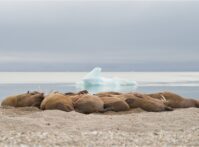-
ECSP Weekly Watch | March 24 – 28
March 28, 2025 By Breanna Crossman
A window into what we’re reading at the Wilson Center’s Environmental Change and Security Program
Marine Protected Areas in Tanzania Boost Living Standards (Mongabay)
In the 1990s, Tanzania established five multiuse Marine Protected Areas (MPAs) to help the country protect 30% of its oceans by 2030. However, a new study has found that the MPAs offered benefits beyond marine ecosystems by also improving the quality of life in nearby communities.
Villages adjacent to MPAs saw variables such as food security, home ownership, and access to refrigeration improve significantly when compared to established communities located more than 6 miles away from protected areas. This increase in living standards was attributed to the growth of industries beyond fishing and farming—and especially tourism, which boosts local businesses. Visitors to these communities are attracted by the coral reefs in MPAs, and they buy locally-made products (such as seaweed soaps) from local merchants.
About 20% of Tanzania’s population is heavily dependent on fisheries for its livelihood. And as fish populations decline globally, MPAs have become a powerful tool to reduce reliance on unreliable stocks and drive income diversification.
READ | Fully Protecting the World’s Land, Water, and People Through 30 by 30
OECD Research Finds Climate Action Will Increase Economic Growth (The Guardian)
The Organization for Economic Cooperation and Development (OECD) and the UN Development Program have issued a joint report which concludes that ambitious climate action could result in a net gain to global GDP. A lack of action could lead to a corresponding loss of one third of global GDP by 2050.
Critics of net zero have argued that transitioning to a low-carbon economy would paralyze economic growth. However, the new research found that climate-driven effects like extreme weather could shave 1% off Europe’s GDP by 2050, and even shrink its economy by 2.3%. A climate breakdown could also lead to a decline in food production and a domestic and international migration crisis.
The benefits of proactive climate action would be most pronounced in developing countries. Lower income countries would experience a 124% rise in GDP per capita by 2050, and these activities would also lift 175 million people out of poverty. UN Climate Chief Simon Stiell framed the findings of the report in terms of economic stability and global security: “The climate crisis is an urgent national security crisis that should be at the top of every cabinet agenda.”
READ | Accelerating the Transition: Can the U.S. Support India’s Path to Net Zero?
Global Air Pollution Conference Examines Links to Health Crises (Human Rights Watch)
At the second global conference on air pollution and health, held this week in Cartagena, Colombia, officials and health professionals have discussed how clean air can improve global health. Air pollution is the world’s leading environmental health threat, killing an estimated seven million people annually. Marginalized communities suffering the worst effects.
Around the world, about 7 million people are killed every year by the effects of air pollution. Human Rights Watch (HRW) is among the organizations highlighting the devastating toll of fossil fuel pollution in communities facing severe health risks, including Louisiana’s “Cancer Alley,” the UAE, and Türkiye.
These trends have prompted 47 million health professionals and advocates to sign a call for urgent action on air pollution. The UN recognizes clean air as a human right, and yet billions of citizens around the world remain exposed to polluted air. And as fossil fuels accelerate both air pollution and climate change, the Cartagena conference offers a pivotal opportunity for policymakers to make progress on twin crises.
LISTEN | What Can California Teach the Federal Government on Air Pollution? A Conversation With Richard Corey
Sources: Guardian, Human Rights Watch, Mongabay, Nature, Society for Conservation Biology, West Indian Ocean Journal of Marine Science
 A Publication of the Stimson Center.
A Publication of the Stimson Center.








